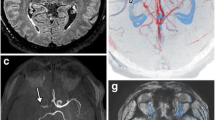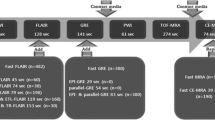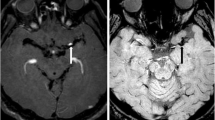Abstract
Objective
Fluid-attenuated inversion recovery (FLAIR) vascular hyperintensities (FVH), initially described on 2D FLAIR images, are a useful imaging marker in patients with acute ischaemic stroke. We aimed to compare the sensitivity of the 3D CUBE FLAIR sequence with 2D FLAIR for the detection of FVH.
Methods
Forty-seven consecutive patients admitted for a suspected stroke were explored by 2D and 3D CUBE FLAIR MR sequences at 1.5 and 3 T. Three blinded readers assessed FVH defined as hyperintensities within cerebral arteries. Location of FVH, acute brain infarct and arterial stenosis were also assessed. 2D images were compared with 3D images for the detection of FVH. Agreement between readers was assessed.
Results
Of the 47 patients, 21 FVHs were observed on 2D FLAIR images of 15 patients (11 with acute brain infarct and 11 with an arterial stenosis). No FVH was visualised on 3D CUBE FLAIR images for either proximal or distal locations. Agreement between readers was excellent.
Conclusion
FVHs are not visible using 3D CUBE FLAIR images. This study suggests that, in suspected acute ischaemic stroke, the assessment of FVH should only be performed on conventional 2D FLAIR images.
Key Points
• Fluid-attenuated inversion recovery (FLAIR) vascular hyperintensities (FVH) are of neuroradiological importance.
• FVHs are useful imaging markers in patients with an acute ischaemic stroke.
• FVHs are not visible using 3D CUBE FLAIR images.
• Assessment of FVH should be performed on conventional 2D FLAIR images.


Similar content being viewed by others
Abbreviations
- ACA:
-
Anterior cerebral artery
- AICA:
-
Anterior inferior cerebellar artery
- CSF:
-
Cerebrospinal fluid
- FLAIR:
-
Fluid-attenuated inversion recovery
- FVH:
-
Fluid-attenuated inversion recovery vascular hyperintensities
- MCA:
-
Middle cerebral artery
- PCA:
-
Posterior cerebral artery
- PICA:
-
Posterior inferior cerebellar artey
- rtPA:
-
Recombinant tissue plasminogen activator
- SCA:
-
Superior cerebellar artery
References
Cosnard G, Duprez T, Grandin C et al (1999) Fast FLAIR sequence for detecting major vascular abnormalities during the hyperacute phase of stroke: a comparison with MR angiography. Neuroradiology 41:342–346
Iancu-Gontard D, Oppenheim C, Touze E et al (2003) Evaluation of hyperintense vessels on FLAIR MRI for the diagnosis of multiple intracerebral arterial stenoses. Stroke 34:1886–1891
Kamran S, Bates V, Bakshi R et al (2000) Significance of hyperintense vessels on FLAIR MRI in acute stroke. Neurology 55:265–269
Maeda M, Yamamoto T, Daimon S et al (2001) Arterial hyperintensity on fast fluid-attenuated inversion recovery images: a subtle finding for hyperacute stroke undetected by diffusion-weighted MR imaging. AJNR Am J Neuroradiol 22:632–636
Toyoda K, Ida M, Fukuda K (2001) Fluid-attenuated inversion recovery intraarterial signal: an early sign of hyperacute cerebral ischemia. AJNR Am J Neuroradiol 22:1021–1029
Tsushima Y, Endo K (2001) Significance of hyperintense vessels on FLAIR MRI in acute stroke. Neurology 56:1248–1249
Lee KY, Latour LL, Luby M et al (2009) Distal hyperintense vessels on FLAIR: an MRI marker for collateral circulation in acute stroke? Neurology 72:1134–1139
Sanossian N, Saver JL, Alger JR et al (2009) Angiography reveals that fluid-attenuated inversion recovery vascular hyperintensities are due to slow flow, not thrombus. AJNR Am J Neuroradiol 30:564–568
Azizyan A, Sanossian N, Mogensen MA et al (2011) Fluid-attenuated inversion recovery vascular hyperintensities: an important imaging marker for cerebrovascular disease. AJNR Am J Neuroradiol 32:1771–1775
Liebeskind DS (2004) Collateral therapeutics for cerebral ischemia. Expert Rev Neurother 4:255–265
Bink A, Schmitt M, Gaa J et al (2006) Detection of lesions in multiple sclerosis by 2D FLAIR and single-slab 3D FLAIR sequences at 3.0 T: initial results. Eur Radiol 16:1104–1110
Mike A, Glanz BI, Hildenbrand P et al (2011) Identification and clinical impact of multiple sclerosis cortical lesions as assessed by routine 3 T MR imaging. AJNR Am J Neuroradiol 32:515–521
Yamazaki M, Naganawa S, Kawai H et al (2009) Increased signal intensity of the cochlea on pre- and post-contrast enhanced 3D-FLAIR in patients with vestibular schwannoma. Neuroradiology 51:855–863
Busse RF, Hariharan H, Vu A et al (2006) Fast spin echo sequences with very long echo trains: design of variable refocusing flip angle schedules and generation of clinical T2 contrast. Magn Reson Med 55:1030–1037
Kallmes DF, Hui FK, Mugler JP et al (2001) Suppression of cerebrospinal fluid and blood flow artifacts in FLAIR MR imaging with a single-slab three-dimensional pulse sequence: initial experience. Radiology 221:251–255
Lummel N, Schoepf V, Burke M et al (2011) 3D fluid-attenuated inversion recovery imaging: reduced CSF artifacts and enhanced sensitivity and specificity for subarachnoid hemorrhage. AJNR Am J Neuroradiol 32:2054–2060
Naganawa S, Koshikawa T, Nakamura T et al (2004) Comparison of flow artifacts between 2D-FLAIR and 3D-FLAIR sequences at 3 T. Eur Radiol 14:1901–1908
Kawashima M, Noguchi T, Takase Y et al (2009) Decrease in leptomeningeal ivy sign on fluid-attenuated inversion recovery images after cerebral revascularization in patients with Moyamoya disease. AJNR Am J Neuroradiol 31:1713–1718
Cheng B, Ebinger M, Kufner A et al (2012) Hyperintense vessels on acute stroke fluid-attenuated inversion recovery imaging: associations with clinical and other MRI findings. Stroke 43:2957–2961
Lisanti C, Carlin C, Banks K et al (2007) Normal MRI appearance and motion-related phenomena of CSF. AJR Am J Roentgenol 188:716–725
Bakshi R, Caruthers SD, Janardhan V et al (2000) Intraventricular CSF pulsation artifact on fast fluid-attenuated inversion-recovery MR images: analysis of 100 consecutive normal studies. AJNR Am J Neuroradiol 21:503–508
Chagla GH, Busse RF, Sydnor R et al (2008) Three-dimensional fluid attenuated inversion recovery imaging with isotropic resolution and nonselective adiabatic inversion provides improved three-dimensional visualization and cerebrospinal fluid suppression compared to two-dimensional flair at 3 Tesla. Invest Radiol 43:547–551
Dani KA, Latour LL, Warach S (2012) Hyperintense vessel sign on fluid-attenuated inversion recovery MR imaging is reduced by gadolinium. AJNR Am J Neuroradiol 33:112–114
Acknowledgments
Cecile Rabrait is an employee of General Electric.
Author information
Authors and Affiliations
Corresponding author
Rights and permissions
About this article
Cite this article
Hodel, J., Leclerc, X., Rodallec, M. et al. Fluid-attenuated inversion recovery vascular hyperintensities are not visible using 3D CUBE FLAIR sequence. Eur Radiol 23, 1963–1969 (2013). https://doi.org/10.1007/s00330-013-2796-z
Received:
Revised:
Accepted:
Published:
Issue Date:
DOI: https://doi.org/10.1007/s00330-013-2796-z




